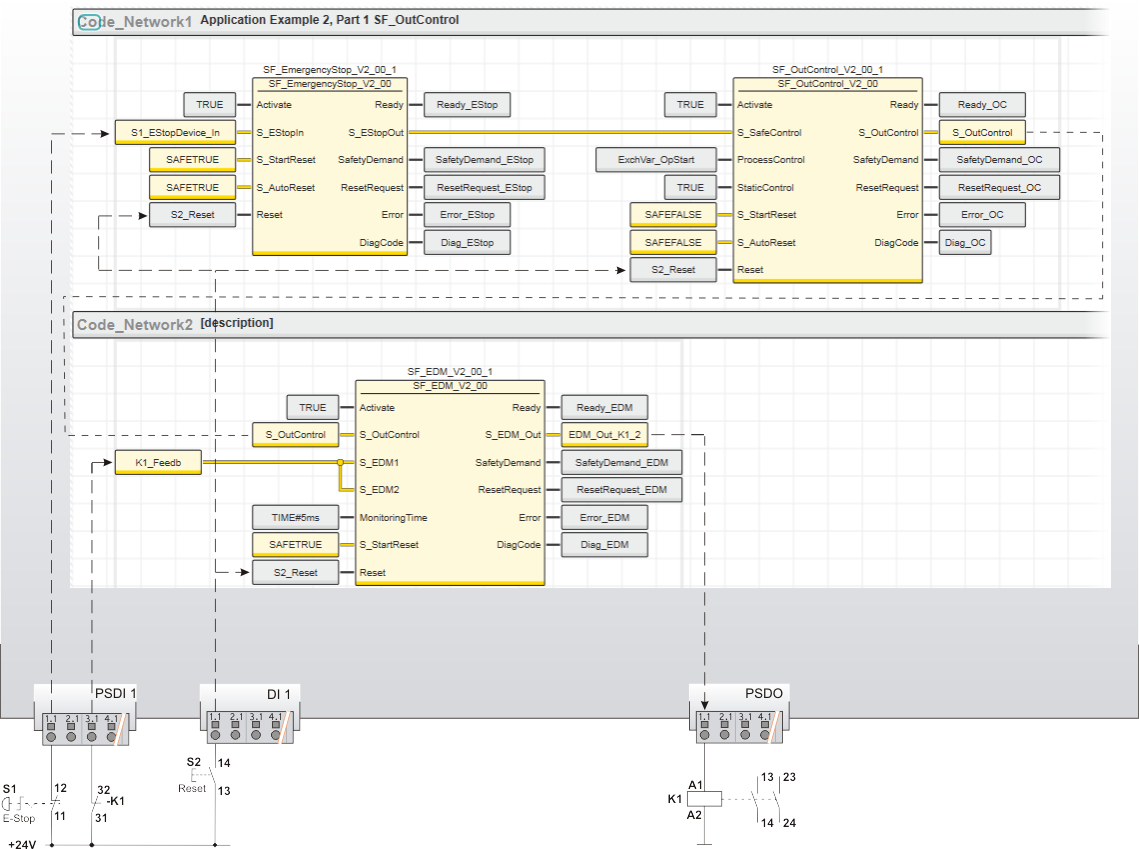Additional application example
In this chapter you will find another possible application, in which the function block can be used for realization of a signal acknowledgement from the standard controller.
The function block must only be used in an actual application once a risk analysis has been conducted.
Details of the risk category/SIL/PL have not been included here, as classification is always based on the application in which the function block is used.
| Note
The use of the function block alone is not sufficient to execute the safety-related function according to the Cat./SIL/PL determined by the risk analysis. In conjunction with the safety-related I/O device used, additional measures must be taken to meet the requirements of the safety-related function. These include, for example, the appropriate wiring and parameterization of the inputs and outputs as well as measures to exclude (design out) errors that cannot be detected. For additional information, please refer to the documentation provided with the safety-related I/O device used. |
| Note
Please refer to the notes in the User Manual on proper electrical connection of the Safety PLC and the extension modules (e.g., connecting the emergency-stop control device). |
| Further Info
Please refer also to the application example in the overview for this function block. |
Control of a backreadable output, additionally required operation stop configured
This example shows the control of a safety-related output with the safety-related SF_OutControl function block for monitoring a connected contactor. An additional operation stop of the standard controller is required by applying the FALSE constant at the StaticControl input.
| Note
As a backreadable output is to be controlled in this example, the S_OutControl enable output must be connected to the safety-related output in the application via the SF_EDM function block. Direct control of backreadable outputs with the enable output of the SF_OutControl function block is not permitted. |
All function blocks involved are perpetually activated by means of TRUE constants at the Activate input.
An emergency-stop control device S1 is connected as single-channel to the input terminal 1.1 of the safety-related input device PSDI 1 and assigned to the global I/O variable S1_EStopDevice_In. This global I/O variable is connected to the S_EStopIn function block input of the SF_EmergencyStop function block. Neither a start-up inhibit nor a restart inhibit is specified for the SF_EmergencyStop function block (SAFETRUE constant at both inputs S_StartReset and S_AutoReset).
Instead, both inhibits are configured at the SF_OutControl function block: The S_StartReset = SAFEFALSE input specifies a start-up inhibit after the Safety PLC has been started up or the function block has been activated. S_AutoReset = SAFEFALSE configures a restart inhibit after the request for the safety-related function has been removed, i.e., after the SAFETRUE signal has returned at the S_SafeControl function block input. Both inhibits are only removed when there is a positive signal edge at the Reset input. To this end, the S2 reset button is connected to input 1.1 of the standard input device DI 1. Its signal is assigned to the global I/O variable S2_Reset, which is connected to the Reset input of the SF_OutControl function block.
Further connection of the SF_OutControl function block:
- The S_EStopOut enable output of the SF_EmergencyStop function block signals the status of the safety-related function and is directly connected to the S_SafeControl function block input.
- The ProcessControl input of the SF_OutControl function block is controlled by a signal from the standard controller. The operation start/stop is signaled by the ExchVar_OpStart exchange variable. ProcessControl signals whether or not the standard controller requests to switch the S_OutControl enable output to SAFETRUE.
- A FALSE constant is applied to the StaticControl input, i.e., an additional operation stop of the standard controller is required. This means the signal at ProcessControl must be FALSE and then change to TRUE before the request for the safety-related function has been removed (S_SafeControl input) by deactivation of the emergency-stop control device and before function block activation. A permanent TRUE at ProcessControl results in an error in this situation. In case of an error, the S_OutControl enable output remains in the defined safe state (SAFEFALSE) and the Error output switches to TRUE.
- The S_OutControl function block output is directly connected to the S_OutControl input of the SF_EDM function block.
The SF_EDM function block must be used to control a backreadable output. SF_EDM is connected as follows:
- The S_OutControl input is directly connected to the S_OutControl enable output of the SF_OutControl function block.
- One-channel feedback via input terminal 3.1 of the safety-related input device PSDI 1 (one-channel up to cat. 2) is provided from contactor K1 via an N/C contact. The resulting signal of the input terminal is assigned to the global I/O variable K1_Feedb, which is connected to the inputs S_EDM1 and S_EDM2.
- The global I/O variable EDM_Out_K1_2 is connected to the S_EDM_Out output, which in turn is assigned to the output terminal 1.1 of the safety-related output device PSDO. Contactor K1 is connected to this terminal.
| Further Info
For more detailed information, refer to the description of the corresponding safety-related function block. |
| S1 | Emergency-stop |
| S2 | Reset |
| K1 | Contactor or relay with positively driven contacts |
